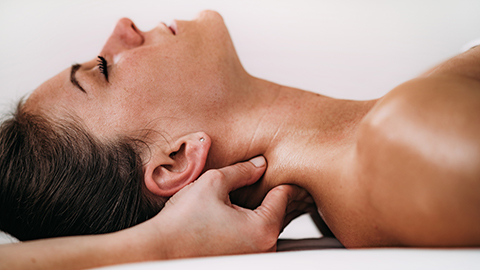
An adult client has Tourette’s syndrome with tics that include various jumps and vocalizations. Her massage therapist notices a surprising change with supine neck work and a traditional craniosacral hold. What is Tourette’s syndrome? What are tics? And why might massage therapy have any kind of influence here? This is a mystery that deserves some attention.
Helpful resources:
Kenney, C. et al. “Tourette’s Syndrome.” American Family Physician 77, no. 5 (2008): 651–58.
Kompoliti, K. et al. “Complementary and Alternative Medicine Use in Gilles de la Tourette Syndrome.” Movement Disorders: Official Journal of the Movement Disorder Society 24, no. 13 (2009): 2015–19. https://doi.org/10.1002/mds.22724.
Pringsheim, T., et al. (2007). “Tourette Syndrome and Dystonia.” Journal of Neurology, Neurosurgery, and Psychiatry 78, no. 5 (2007): 544. https://doi.org/10.1136/jnnp.2006.0102442.
Robertson, William C. “Tourette Syndrome and Other Tic Disorders: Practice Essentials, Background, Pathophysiology.” Last updated May 30, 2019. Accessed November 2020. https://emedicine.medscape.com/article/1182258-overview#showall.
“Tourette Syndrome Treatments.” Centers for Disease Control and Prevention. Last updated May 13, 2020. Accessed November 2020. www.cdc.gov/ncbddd/tourette/treatments.html.
“What is Tourette.” (n.d.). Tourette Association of America. Accessed November 2020. http://tourette.wpengine.com/about-tourette/overview/what-is-tourette.


This podcast sponsored by:
00:00 Speaker 1: Ruth Werner's best-selling book, A Massage Therapist's Guide to Pathology is a highly regarded comprehensive resource that sets the standard for pathology education. Written for massage therapy students and practitioners, this groundbreaking resource serves up a comprehensive review of the pathophysiology signs, symptoms and treatment of more than 500 diseases and disorders. Learn more at booksofdiscovery.com. Oakworks is a proud supporter of ABMP and the massage therapy profession, and is happy to extend a special offer to ABMP podcast listeners. For a limited time, all ABMP podcast listeners receive 25% off Oakworks items with the code ABMPSummit25, go to massagetables.com and use the code ABMPSummit25 at check out to receive 25% off your Oakworks purchase.
[music]
01:11 Ruth Werner: Hi, and welcome to I Have a Client Who pathology conversations with Ruth Werner, the podcast where I will discuss your real life stories about clients with conditions that are perplexing or confusing. I'm Ruth Werner, author of A Massage Therapist's Guide to Pathology, and I have spent decades studying, writing about and teaching about where massage therapy intersects with diseases and conditions that might limit our client's health. We almost always have something good to offer even with our most challenged clients, but we need to figure out a way to do that safely, effectively and within our scope of practice, and sometimes as we have all learned, that is harder than it looks. Today's story comes from a massage therapist in New Jersey who shares this, "I have a client who is a 27-year-old woman with Tourette Syndrome, and she's just moved home with her parents, her tics include various jumps and vocalizations, and she has posture that looks like Upper Crossed Syndrome. She requests deep tissue work and I've seen her for three visits so far, at the end of her sessions, I use an upledger style cranial hold for under a minute and she has no jumps." So I followed up with this massage therapist to see what else I could find out about this very interesting client.
02:39 RW: And here's what she said, "I only got to see her for a very limited number of sessions, and after the one hour of therapeutic massage where I finished her session with supine neck work, I take a lot of general satisfaction and I kind of play with that upledger cranial hold as an ending for that appointment, I really enjoy accessing my clients state and playing with it to notice if a still point is present and this girl she was in stillness and her body was too." As always, I wanna offer my special thanks to this massage therapist from New Jersey, who has shared this fascinating story about a condition I really don't know very much about Tourette Syndrome, so I'm especially grateful for the opportunity to dig a little deeper into this situation.
03:26 RW: I'd also like to invite you to send me your, I Have a Client Who stories at ihaveaclientwho@abmp.com, that's ihaveaclientwho all one word, all lower case @abmp.com. To gather information to share with you about Tourette Syndrome, I consulted... Some of my favorite resources, I went to emedicine.com, and then I augmented what I found there with information from the Tourette Syndrome Foundation and the Centers for Disease Control, and a few research articles, and all of these resources are listed in the show notes, so if you have clients who have Tourette Syndrome, there might be something useful for you here. I will come back and talk about this massage therapist's hands-on work and strategies in a little bit.
04:17 RW: But first, let's take a closer look at Tourette's Syndrome. This is named for a French neurologist Gilles de la Tourette, who compiled early case studies where this condition was named in 1885, it's a neurological problem that usually has an early onset some time in childhood, we think it occurs in about one out of every 160 school age children, although about half of them may be undiagnosed, numbers in adults are essentially completely unknown, but it's much less frequent in adults, as most of the time we see these tics decline in late adolescence, there's a lot of overlap between Tourette Syndrome and some other conditions, including ADHD, obsessive-compulsive disorder, anxiety and several other challenges.
05:11 RW: Tourette's is seen anywhere from three to five times more frequently in males compared to females. So this client is unusual in a couple of ways, as a 27-year-old, it's not typical to see Tourette Syndrome still active and having a big impact on someone's life. And also as a woman, she's very much in the minority for people who tend to be affected with this condition. Tourette Syndrome is one of a whole group of problems under the umbrella of tic disorders that involve these involuntary repetitive movements and vocalizations, other tic disorders include persistent or chronic motor or vocal tic disorder, and another thing called provisional tic disorder, and a tic is simply an abnormal movement or vocalization, they can look like a lot of different things, they are usually categorized as motor or vocal and as simple or complex.
06:12 RW: Motor tics involve activities like eye blinking or grimacing, or head bobbing and a bunch of others, these can be really simple involving only one or a small group of muscles, or they can involve multiple muscle groups or combinations of movements, and we call those complex motor tics. The vocal or phonic tics is anything that produces a sound, this could be sniffing or throat clearing or coughing or other noises. Complex vocal tics are...
06:41 RW: When we have whole words or phrases that are typically out of context. In a very small percentage of cases, the words may be inappropriate, like swear words or ethnic slurs or things that are otherwise unacceptable, this kind of vocal tic is called coprolalia, which literally means dung tongue. I wanna emphasize that coprolalia is really rare, regardless how often it is inaccurately portrayed in popular culture. We don't really know what causes Tourette Syndrome. Right now, the main theory is that it's an inherited condition that impacts neurotransmitters, the fact that it is often treated with various levels of success with drugs that affect neurotransmitter secretion and uptake in the brain that supports this idea. In some cases, there is an indication that Tourette Syndrome develops after a really severe childhood bout with a streptococcus infection, but this isn't a consistent outcome, however, it's an interesting line of possibility that some experts are looking at.
07:48 RW: Tics can be really serious issues for children, especially if their teachers don't know how to make appropriate accommodations, but for most adults who have Tourette's, their tics are not hugely impactful in their quality of life and they don't require aggressive treatment, however, for some people, tics can be painful, they can increase the risk of self-injury or they can impact a person's ability to hold a job or interact comfortably with others to the extent that treatment is important in order to manage their condition. So these treatments can involve drugs that affect neurotransmitter secretion and uptake like SSRIs, but there are also a couple of behavioral interventions and one specifically called Comprehensive Behavioral Intervention for Tics or CBIT.
08:35 RW: And this includes principles of habit reversal, introducing alternative behaviors, education about tics, and here's the kicker, relaxation techniques. Tics in Tourette Syndrome often occur in people who have other neurological issues like ADHD or OCD, as we've said. I'm also really interested in the overlap between Tourette Syndrome and Dystonia, which has some sub-types that can look really similar, but they're not the same thing. For instance, with Tourette Syndrome, there's a sense of physical relief or satisfaction after a person does these behaviors that does not happen with Dystonia. When people, especially children, work really hard to suppress their tics, then they often experience a period where they have to sort of overcompensate and catch up with a lot of tics in order to feel normal again, and we don't see this with Dystonia, which appears to be... A more reflexive activity that happens below levels of conscious awareness or control, I feel like I have a particular connection with people who have tics because I live with a chronic cough that has been diagnosed as a motor disorder, my cough is a reflex in response to what I perceive as irritation, but when I'm aware of the need to cough with enough careful breathing and compensatory activities, I can suppress that reflex, but then I often feel like I have to make up for it later, like right after I finish recording this podcast. But let's talk now, about massage for people with Tourette's.
10:16 RW: This massage therapist was working with this client who, based on the introduction she gave us was not seeking massage therapy as a way to help deal with her tics, but instead was looking for some deep tissue work probably for upper back pain related to Upper Crossed Syndrome. The conclusion of the massage with supine neck work and a traditional upledger type cranial hold seem to induce a still point or at least some stillness throughout the body of this person with Tourette Syndrome. This is a really interesting phenomenon. I truly have no idea what the mechanisms that might be at work here could be, possibly tuning into a deeply relaxing state helps to decrease involuntary contractions. We do see that Tourette's tends to be exacerbated by stress or fatigue. I don't know a lot about the mechanisms for craniosacral therapy. I know that some of the explanations that are offered seem implausible and not supported by the research, but that doesn't mean... Nothing happens. I can speak from my own experience and from seeing it with my children, that craniosacral work for some people can be deeply impactful. Clearly with this client, something fascinating is going on. I would love to see someone take this up as a possible case report, if they have a client with Tourette's who would like to see if massage therapy might have any significant impact.
11:47 RW: What this therapist reports is that the client had a reduction in her involuntary muscle contractions during the cranial hold, but of course, we have no indication for whether that change had any kind of duration, that of course would be a really interesting and important question, especially since relaxation techniques are included in the behavioral therapies that people with Tourette's may be recommended to undertake. I'm also really interested to know what would happen if a massage began with a cranial hold for a client with Tourette rather than... Or in addition to concluding with it, I wonder if that might impact the client's ability to relax and then also enjoy their massage experience. If you have clients who have Tourette Syndrome and you have found some ways with body work that appear to offer some relief, at least while they're on the table, I'd love to hear about that, I'd be delighted to do a follow-up. I have a client who podcast on this topic, because I suspect that massage therapy may have a lot more to offer for this population than we have begun to explore. So let me know and we'll talk about it.
13:05 RW: Hey everybody, thanks for listening to I Have a Client Who pathology conversations with Ruth Werner. Remember, you can send me your I Have a Client Who stories to ihaveaclientwho@abmp.com, that's ihaveaclientwho all one word, all lower case @abmp.com. I can't wait to see what you send me and I'll see you next time.
13:31 S1: Anatomy Trains is excited to announce a new on-demand video course with Tom Myers coming soon, Deeper Ground: Restoration and Vitality for the Female Pelvis, reach your deeper ground of embodied awareness and strategic confidence with this four-hour tour of the female pelvis, including its key points and unique challenges. Course highlights include, hands-on palpation, certainty and technique review for the major muscle groups, assessments and techniques for posterior and anterior pelvic floor, so as complex and diaphragm, common perinatal bio-mechanical issues explained and much more. Sign up for the Anatomy Trains newsletter at anatomytrains.com to be notified when the course is available.